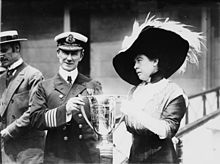Arthur Rostron

Sir Arthur Henry Rostron , KBE (born May 14, 1869 in Astley Bridge , Lancashire , † November 4, 1940 in Chippenham , Wiltshire ) was a British captain . As the skipper of the steamer Carpathia , he achieved great fame by rescuing over 700 survivors of the Titanic disaster of April 15, 1912.
family
Rostron was the son of James Rostron (1839-1911) and his wife Nancy Lever (approx. 1843-1888). On September 14, 1899, he married Ethel Minnie Stothert in Atherton , who died on July 7, 1943 at the age of 69. The marriage had four children: Harry Maxwell (1900–1979), Robert James (1903–1984), Arnold Richard (1907–?) And Margaret Ethel (1915–2005, later Mrs. John F. Howman).
education
After attending Astley Bridge High School , Rostron joined the British Merchant Navy on the training ship Conway at the age of 13 . After two years of training, he joined the Waverley Line from Messrs. Williamson, Milligan and Co. in Liverpool on the Cedric of Saxon clipper . After three years of voyage to all parts of the world, Rostron went on the Bark Red Gauntlet of the same shipping company. After a good two years of experience as a second officer , he switched to the Bark Camphill , which was used on the route to the west coast of South America .
In 1894 he switched to the steamship Concord , on which he passed the Extra Master's certificate .
In service with the Cunard Line
In January 1895, Rostron went to the Cunard Line , where he held the post of fourth officer on the RMS Umbria . In the following years he served on various steamers of the Cunard Line .
As a captain
As first officer he was to accompany the Lusitania's maiden voyage in early September 1907 . Just one day earlier he received his first command as captain on the Brescia , a freighter on lines in the Mediterranean . In the years to come, Rostron commanded other freighters such as the Verria and the Pavia . As a member of the Royal Naval Reserve, Rostron was allowed to temporarily leave the Cunard Line to serve in the British Royal Navy during the Russia-Japan War . He received command of his first passenger ship in 1911 on the Pannonia , which operated between New York City and the Mediterranean. He then switched to the steamer Carpathia on January 18, 1912 , with which he was able to rescue 705 survivors of the Titanic disaster in April 1912 during a voyage from New York to Fiume . Because of his almost inexhaustible energy during the action, he was nicknamed "The Electric Spark".
After a year on the Carpathia , Rostron was transferred to the Caronia . Between 1913 and the end of 1914 he commanded Carmania , Campania , Lusitania and Aurania . The First World War broke out when Rostron captain of Aurania was. The ship was quickly converted into a troop transport and drove under his command with the first Canadian troops to Plymouth . Then the ship went to India .
Between September 1915 and April 1916 he commanded the Mauretania . This passenger steamer was then used as a hospital ship . He then switched to the Ivernia , which was used in the Mediterranean. Towards the end of 1916 Rostron left the Ivernia in Marseille and took over the Mauretania again. He then drove to Andania , Saxonia and the Carmania before taking over the Mauretania again . The ship was released from military service in 1919 and returned to its traditional place in the North Atlantic service. Rostron stayed on the Mauretania until July 1928 , with which he set several speed records.
Arthur Rostron succeeded James Charles as captain of the Berengaria in 1928 . In addition, Rostron was appointed commodore of the Cunard fleet. Rostron last docked with the Berengaria in Southampton in May 1931 when he retired. In retirement he wrote his biography "Home From The Sea". The Berengaria , built in Germany and the last ship he was allowed to command in his long career at sea, was only mentioned in his memoirs in a subordinate sentence as “the most comfortable ship he would have ever served”. On the other hand, he devoted an entire chapter to the faster, smaller, older, but thoroughly “English” Mauretania .
Captain Rostron died of pneumonia at Chippenham Cottage Hospital at the age of 71 . His grave in the old cemetery (Old Burial Ground) of West End, county Hampshire , a suburb of Southampton , is preserved.
Sources and literature
- Lord, Walter: Titanic - How it really was , paperback from Heyne-Verlag No .: 10658, 1998
- Lynch, Don: Titanic: An Illustrated History . Hyperion 1993. ISBN 0-7868-8147-X .
Web links
Individual evidence
| personal data | |
|---|---|
| SURNAME | Rostron, Arthur |
| ALTERNATIVE NAMES | Rostron, Arthur Henry (full name) |
| BRIEF DESCRIPTION | British captain |
| DATE OF BIRTH | May 14, 1869 |
| PLACE OF BIRTH | Astley Bridge , Lancashire |
| DATE OF DEATH | November 4th 1940 |
| Place of death | Southampton |